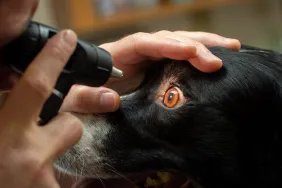Hyperparathyroidism in dogs is a condition that happens when the parathyroid glands produce unusually high levels of parathyroid hormone (PTH), which results in an increase in blood calcium levels.
Normally, the parathyroid glands maintain calcium and phosphorus levels in the blood. When calcium levels drop, PTH levels increase, and the blood absorbs calcium from bone to compensate. When the parathyroid glands become overactive, PTH levels elevate too high, and blood calcium levels also rise too high — a condition known as hypercalcemia.
Hyperparathyroidism can either be primary, which is the result of a tumor in the parathyroid gland, or secondary, which arises due to malnutrition or kidney disease.
If you see the signs of hyperparathyroidism in your dog, then you should consult your veterinarian for a proper diagnosis and treatment. Here’s what you should know about the symptoms, causes, and treatments for hyperparathyroidism in dogs.
Symptoms Of Hyperparathyroidism In Dogs

Most dogs who suffer from hyperparathyroidism don’t show signs of illness, and symptoms that do appear are often mild. This means that by the time you spot signs of the condition, the dog may have already suffered severe organ damage.
Here are some of the symptoms you might see in dogs who suffer from hyperthyroidism:
- Increased thirst or urination
- Loss of appetite
- Weakness
- Vomiting
- Urinary tract stones
- Stupor
- Coma
- Swollen glands (felt in the neck)
- Bone fractures
- Poor bodily health
Causes Of Hyperparathyroidism In Dogs

Primary hyperparathyroidism in dogs is caused by a tumor in the parathyroid gland. Most of the time it is a benign tumor, as malignant tumors on the parathyroid gland are uncommon.
Usually only one of the two parathyroid glands has a tumor. Older dogs are more at risk for this type of hyperparathyroidism.
Secondary hyperparathyroidism in dogs can either arise due to malnutrition or chronic kidney disease.
When there is a deficiency of vitamin D and calcium or too much phosphorus in the diet, the parathyroid gland may produce more PTH to compensate. This often happens in puppies who are fed a diet of entirely meat.
Chronic kidney disease can make it difficult for the kidneys to remove phosphorus from the body and produce hormones that regulate calcium absorption in the intestines. Again, the parathyroid glands produce more PTH to compensate, which can damage the bones and organs.
Overall, Keeshonds are 50 percent more likely to develop hyperparathyroidism than any other breed. People who have Keeshonds or Keeshond mixes should make sure to watch closely for the signs of hyperparathyroidism and keep up with regular veterinary exams to look for any irregularities in blood calcium levels.
Treatments For Hyperparathyroidism In Dogs

The treatment for primary hyperparathyroidism in dogs is surgery to remove the tumor that’s causing the condition. Once the tumor is removed, the recovery rate of dogs is near 100 percent.
Another method of removing the tumor involves using ultrasound imaging to inject the tumor and eliminate it. That method is less invasive and also effective.
A third option is heat ablation, which involves firing radio waves to heat the gland and destroy it. While it is less invasive than surgery, the success rate is less at 90 percent.
These methods may cause the body to stop producing enough PTH, so dogs may need to be given supplemental calcium to maintain healthy levels. The prognosis for recovery from primary hyperparathyroidism is good, though ten percent of dogs who have it see a recurrence.
Secondary hyperthyroidism is usually treated with calcium supplements. If the cause is kidney disease, that will be treated, as well. Veterinarians may prescribe a diet that is low in phosphorus, too.
The prognosis for secondary hyperthyroidism is excellent, so long as pet parents maintain their dogs’ proper nutrition and continue to treat any kidney disease.
Has your dog ever suffered from hyperthyroidism? How was it treated? Let us know in the comments below!









